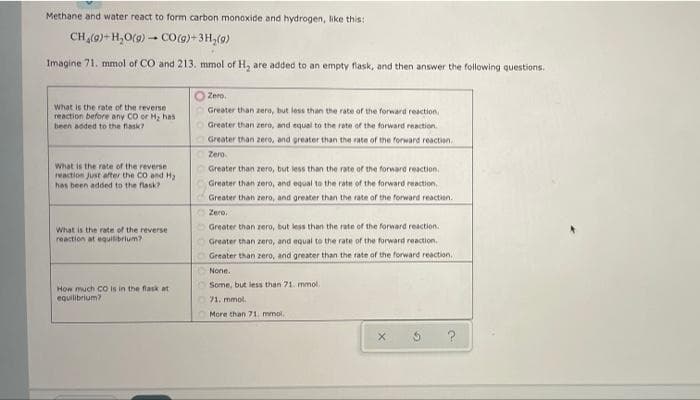Methane and water react to form carbon monoxide and hydrogen, like this: CH,(0)+ H,O(9) - CO(g)+ 3H,(9) Imagine 71. mmol of CO and 213. mmol of H, are added to an empty flask, and then answer the following questions. Zero. What is the rate of the reverse Greater than zero, but less than the rate of the forward reaction, reaction before any CO or Hz has been added to the nask? O Greater than zero, and equal to the rate of the forward reaction. Greater than zero, and greater than the rate of the forward reaction. Zero What is the rate of the reverse reaction Just after the CO and Ha has been added to the flask? Greater than zero, but less than the rate of the forward reaction, Greater than zero, and equal to the rate of the forward reaction, Greater than zero, and greater than the rate of the forward reaction. Zero. What is the rate of the reverse Greater than zero, but less than the rate of the forward reaction. reaction at equilibrium? Greater than zero, and equal to the rate of the forward reaction. Greater than zero, and greater than the rate of the forward reaction. None. Some, but less than 71. mmol How much CO is in the flask at equlibrium? 71. mmol. More than 71 mmol.
Methane and water react to form carbon monoxide and hydrogen, like this: CH,(0)+ H,O(9) - CO(g)+ 3H,(9) Imagine 71. mmol of CO and 213. mmol of H, are added to an empty flask, and then answer the following questions. Zero. What is the rate of the reverse Greater than zero, but less than the rate of the forward reaction, reaction before any CO or Hz has been added to the nask? O Greater than zero, and equal to the rate of the forward reaction. Greater than zero, and greater than the rate of the forward reaction. Zero What is the rate of the reverse reaction Just after the CO and Ha has been added to the flask? Greater than zero, but less than the rate of the forward reaction, Greater than zero, and equal to the rate of the forward reaction, Greater than zero, and greater than the rate of the forward reaction. Zero. What is the rate of the reverse Greater than zero, but less than the rate of the forward reaction. reaction at equilibrium? Greater than zero, and equal to the rate of the forward reaction. Greater than zero, and greater than the rate of the forward reaction. None. Some, but less than 71. mmol How much CO is in the flask at equlibrium? 71. mmol. More than 71 mmol.
Chemistry for Engineering Students
4th Edition
ISBN:9781337398909
Author:Lawrence S. Brown, Tom Holme
Publisher:Lawrence S. Brown, Tom Holme
Chapter10: Entropy And The Second Law Of Thermodynamics
Section: Chapter Questions
Problem 10.67PAE
Related questions
Question
Help me please ASAP

Transcribed Image Text:Methane and water react to form carbon monoxide and hydrogen, like this:
CH,(9)+ H,O(9) - CO(g)+ 3H,(9)
Imagine 71. mmol of CO and 213. mmol of H, are added to an empty fiask, and then answer the following questions.
Zero.
What is the rate of the reverse
reaction before any CO or Hy has
been added to the fask?
Greater than zero, but less than the rate of the forward reaction
Greater than zero, and equal to the rate of the forward reaction.
Greater than zero, and greater than the rate of the forward reaction.
Zero
What is the rate of the reverse
reaction Just after the CO and Hy
has been added to the flask?
Greater than zero, but less than the rate of the forward reaction
Greater than zero, and equal to the rate of the forward reaction.
Greater than zero, and greater than the rate of the forward reaction.
Zere.
Greater than zero, but less than the rate of the forward reaction.
What is the rate of the reverse
reaction at equisibrium?
Greater than zero, and equal to the rate of the forward reaction.
Greater than zero, and greater than the rate of the forward reaction.
None.
Some, but less than 71. mmol.
How much CO is in the flask at
equilibrium?
71. mmol.
More than 71, mmol.
Expert Solution
This question has been solved!
Explore an expertly crafted, step-by-step solution for a thorough understanding of key concepts.
This is a popular solution!
Trending now
This is a popular solution!
Step by step
Solved in 3 steps with 1 images

Knowledge Booster
Learn more about
Need a deep-dive on the concept behind this application? Look no further. Learn more about this topic, chemistry and related others by exploring similar questions and additional content below.Recommended textbooks for you

Chemistry for Engineering Students
Chemistry
ISBN:
9781337398909
Author:
Lawrence S. Brown, Tom Holme
Publisher:
Cengage Learning

Chemistry by OpenStax (2015-05-04)
Chemistry
ISBN:
9781938168390
Author:
Klaus Theopold, Richard H Langley, Paul Flowers, William R. Robinson, Mark Blaser
Publisher:
OpenStax

Chemistry: The Molecular Science
Chemistry
ISBN:
9781285199047
Author:
John W. Moore, Conrad L. Stanitski
Publisher:
Cengage Learning

Chemistry for Engineering Students
Chemistry
ISBN:
9781337398909
Author:
Lawrence S. Brown, Tom Holme
Publisher:
Cengage Learning

Chemistry by OpenStax (2015-05-04)
Chemistry
ISBN:
9781938168390
Author:
Klaus Theopold, Richard H Langley, Paul Flowers, William R. Robinson, Mark Blaser
Publisher:
OpenStax

Chemistry: The Molecular Science
Chemistry
ISBN:
9781285199047
Author:
John W. Moore, Conrad L. Stanitski
Publisher:
Cengage Learning